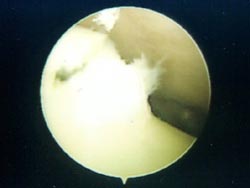What are cartilage defects?
Cartilage defects in the ankle are areas of damage to the specialised lining of the joint surface. The ankle does not have any ’shock absorber’ cartilages (menisci) like the ones found in the knee.
Why do they develop?
In most cases they occur following trauma, it is not certain why the others occur, but there are a number of theories.
What symptoms does they cause?
Pain: this is usually deep seated within the ankle.
Catching/ Locking: this can occur if there is a loose flap of cartilage.
Instability: this is usually more of an insecurity caused by the pain and/ or catching sensation.
What options are there for treatment?
a. Analgesia/ Bracing
It is not known how many people have developed cartilage defects after ankle injuries that settle with simple measures of rest, analgesia and bracing, as not everyone undergoes a routine review by a specialist +/- scans following an ankle injury, however it is suspected that a number do. If you have symptoms for three months following an ankle sprain there is probably a good reason and a cartilage defect is one of potential causes.
 b. Surgery
b. Surgery
The aim of surgery is to remove any flaps of cartilage that may lead to the catching sensation described above (see image, right), smooth any loose edges of cartilage and fill in the resutant defect with replacement cartilage. There are a number of different options to achieve this, these are mainly performed via keyhole (arthroscopic) surgery:
i. Marrow stimulation techniques
In these the aim is to stimulate the bone under the cartilage defect to form new replacement cartilage, this is successful in about 80% of cases. See: Ankle Arthroscopy Surgery.
ii. Autologous chondrocyte implantation (ACI)
This involves removing some cartilage from the ankle surface at one operation and then growing the cartilage in the laboratory. A further operation is required to implant the grown cartilage to cover the defect. As this technique requires two operations and is very expensive, it is reserved for cases that have failed to respond to marrow stimulation techniques.
iii. OATS
This technique involves removing plugs of bone and cartilage from the knee to insert into the ankle. In order to gain sufficient access to insert the plug it may be necessary to break the ankle (i.e perform an osteotomy). In view of this, and the fact that removing the cartilage from the knee can lead to knee pain, like ACI it tends to be reserved for cases where marrow stimulation techniques have failed.
